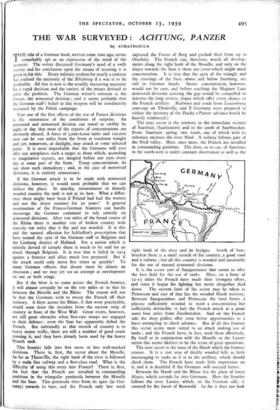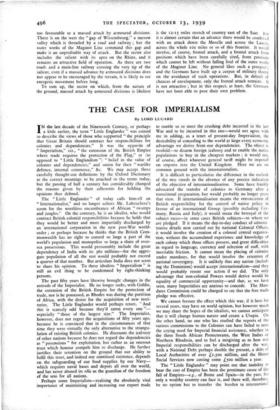THE WAR SURVEYED : ACHTUNG, PANZER
By STRATEGICUS
THE title of a German book, written some time ago, seems remarkably apt as an expression of the mind of the moment. The writer discussed Germany's need of a swift victory and his conclusion upon the means of securing it is given in his title. Every military student for nearly a century has realised the necessity of the Blitzkrieg if a war is to be profitable. All that is new is the steadily increasing necessity for a rapid decision and the variety of the means devised to solve the problem. The German writer's solution is the Panzer, the armoured division ; and it seems probable that the German staff's belief in this weapon will be inordinately increased by the Polish campaign.
Now one of the first effects of the use of Panzer divisions is the restoration of the conditions of surprise. An armoured and motorised division can travel so swiftly by night or day that most of the reports of concentrations are obviously absurd. A force of 5,000-6,000 tanks and 150,000 men can be too miles from the front at sundown tonight and yet, tomorrow, at daylight, may attack at some selected point. It is most improbable that the Germans will ever offer our aeroplanes such a target as those which, according to imaginative reports, are dangled before our eyes every day at some part of the front. Troop concentrations do not show such immodesty ; and, in the case of motorised divisions, it is entirely unnecessary.
If the German attack is to be made with armoured divisions, however, it would seem probable that we can deduce the place. In marshy, mountainous or densely wooded country the tank is not at its best. What a differ- ence there might have been if Poland had had the wettest and not the driest summer for 5o years! A general examination of the Franco-German frontiers can hardly encourage the German command to rely entirely on armoured divisions. After too miles of the broad course of the Rhine there is another too of broken country with scarcely ten miles that is flat and not wooded. It is this and the natural affection for Schlieffen's prescription that have turned the eyes of the German staff to Belgium and the Limburg district of Holland. For a nation which is entirely devoid of scruple there is much to be said for an attack through Belgium. It is true that it failed in 1914 against a frontier and allies much less prepared. But if the attack could only move five times as quickly! To many German officers that dream must be almost an obsession ; and we may yet see an attempt at envelopment on one or both wings.
But if the blow is to come across the French frontier, it will almost certainly be on the too miles or so that lie between the Moselle and the Rhine. The reason will not be that the Germans wish to sweep the French off their territory. A blow across the Rhine, if that were practicable, would soon draw the invaders from the narrow strip of country in front of the West Wall. Great rivers, however, are still great obstacles when first-rate troops are engaged in their defence: even the Saar has apparently defied the French. But unfriendly as this stretch of country is to heavy motor traffic, there are still a number of good roads crossing it, and they have already been used by the heavy French tank.
This frontier falls into five more or less well-marked divisions. There is, first, the sector about the Moselle. As far as Thionville, the right bank of the river is followed by a main line railway and a first-class road. What is the difficulty of using this entry into France? There is, first, the fact that the French are installed in commanding positions in the triangular peninsula between the Moselle and the Saar. This peninsula rises from its apex (in Ger- many) towards its base, and the French only last week captured the Forest of Borg and pushed their front up to Orscholz. The French can, therefore, watch all develop- ments along the right bank of the Moselle, and only on the slopes towards the Saar is there any cover which might mask concentration. It is true that the apex of the triangle and the crossings of the Saar, above and below Saarburg, are still in German hands. Secret concentration, however, would not be easy, and before reaching the Maginot Line armoured divisions crossing the gap would be compelled to traverse the long reverse slopes which offer every chance to the French artillery. (Railways and roads from Luxemburg converge on Thionville, and if Germany were prepared to violate the territory of the Duchy a Panzer advance would be heavily reinforced.) The next sector is the territory in the immediate vicinity of Saarlouis (Saarlautern) and to the south of Saarbrucken. From Saarlouis spring two roads, one of which with its tributary encloses the river Nied. A railway follows part of the Nied valley. Here, once more, the French are installed in commanding positions. The door, so to say, of Saarlouis to the south-west is under constant observation as well as the right bank of the river and its bridges. South of Saar- brucken there is a small stretch of flat country, a good road and a railway ; but all this country is wooded and unsuitable for the use of massed armoured divisions.
It is the sector east of Saarguemines that seems to offer the best field for the use of tanks. Here, on a front of 12-15 miles the French have made their strongest effort, and since it began the fighting has never altogether died down. The eastern limit of the sector may be taken as Pirmasens and east of that lies the wooded Hardt territory. Between Saarguemines and Pirmasens the land forms a plateau sufficiently wooded to mask a concentration but sufficiently defensible to halt the French attack at a point some four miles from Zweibriicken. And on the French side the deep gullies offer even better opportunities to a force attempting to check advance. But of all this frontier this sector seems most suited to an attack making use of tanks ; and the French have, in fact, used them effectively. By itself or in conjunction with the Moselle or the Lauter sector this seems likeliest to be the scene of great operations.
The next sector is the mass of the Hardt which the frontier crosses. It is a vast area of thickly wooded hills as little encouraging to tanks as it is to the artillery, which should check them. The French have made little impression on it, and it is doubtful if the Germans will succeed better.
Between the Hardt and the Rhine lies the plain of lower Alsace, which extends far into Germany. Here the frontier follows the river Lauter, which, on the German side, is covered by the forest of Bienwald. So far it does not look too favourable to a massed attack by armoured divisions. There is on the west the " gap of Wissembourg," a narrow valley which is threaded by a road and railway ; but the outer works of the Maginot Line command this gap and make it an unprofitable way of attack. But the sector also includes the salient with its apex on the Rhine, and it remains an attractive field of operation. As there are two roads and a main-line railway crossing the very tip of the salient, even if a massed advance by armoured divisions does not appear to be encouraged by the terrain, it is likely to see energetic movement before long.
To sum up, the sector on which, from the nature of the ground, massed attack by armoured divisions is likeliest is the tz-i5 miles stretch of country east of the Saar. but it is almost certain that an advance there would be combined with an attack down the Moselle and across the Lamer, across the whole too miles or so of this frontier. It would involve, of course, frontal attack, and a frontal attack from positions which have been carefully sited, from positions which cannot be left without falling foul of the outer works of the Maginot Line. No general likes such a prospect ; and the Germans have built up a corpus of military theory on the avoidance of such operations. But, in default of chances of envelopment, only the frontal attack remains. It is not attractive ; but in this respect, at least, the Germans have not been able to pose their own problem.











































 Previous page
Previous page